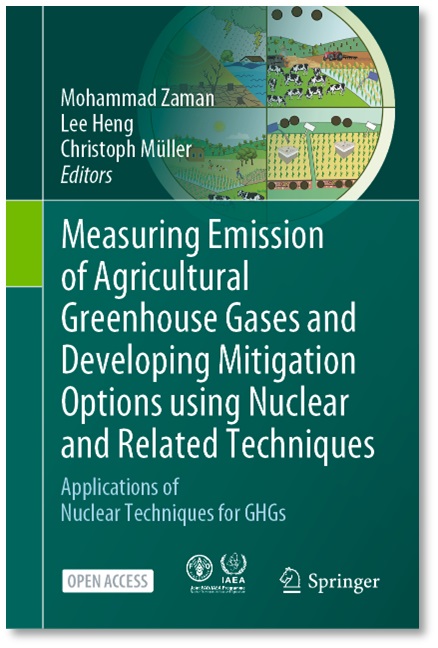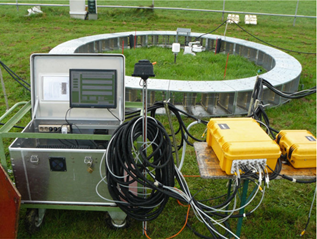It’s now common knowledge that the atmospheric carbon dioxide concentration is increasing steadily due to the burning of fossil fuels, and that the increase in emissions of greenhouse gases (GHGs) like carbon dioxide is causing climate change and triggering substantial changes in our ecosystems. One effect of increasing carbon dioxide concentrations is a higher photosynthetic activity that leads to more plant growth. The enhanced photosynthetic carbon fixation is an important additional global carbon dioxide sink that slows down the increase in atmospheric carbon dioxide concentration. To investigate how plant growth will be affected in the future, ecologists and plant biologists have set up Free-Air Carbon dioxide Enrichment (FACE) facilities in various ecosystems around the world that imitate elevated atmospheric carbon dioxide concentrations. A FACE facility consists of a set of pipes that emit air with elevated carbon dioxide concentrations and are placed in a circle around the experimental plot. The carbon dioxide concentration is monitored and maintained at the desired level on the plot.
One of the oldest FACE facilities is the Giessen climate change experiment in Germany. Since 1998, it has been used to investigate the response of a semi-natural grassland to changing environmental conditions. The FACE facility from the University of Giessen combines an increase in carbon dioxide concentration of 20% with an increase in air temperature of 2°C and is therefore referred to a T-FACE experiment (air Temperature warming and Free Air Carbon dioxide Enrichment). As elevated plant growth may influence the emission of various GHGs, variations in carbon dioxide, nitrous oxide, methane, and water vapor concentrations are constantly monitored with a set of automatic soil chambers combined with a Picarro G2508 multi-gas species analyzer. The measurement of multiple greenhouse gases allows the investigation of changes in soil processes – one of the applications for which the Picarro G2508 analyzer was designed. It’s perfect for measuring simultaneously and continuously five key trace gases – N2O, CH4, CO2, NH3 and H2O – with ppb level precision and negligible drift – meeting the needs of today’s cutting-edge soil flux studies.

FACE experiments are just one example that illustrate the great value of continuous greenhouse gas monitoring of soils. A detailed technical description of the Giessen T-FACE experiment is given in the recently published Springer open access book on “Measuring Emission of Agricultural Greenhouse Gases and Developing Mitigation Options using Nuclear and Related Techniques” edited by Mohammad Zaman, Lee Heng and Christoph Müller. The objective of the book is to provide protocols and standard operating procedures to scientists and practitioners of soil science. It covers all topics from sample preparation and field monitoring to measurement technologies, data evaluation and data interpretation. A key purpose of the second chapter in the book is to give hands-on guidance on how to best use the Picarro G2508 analyzer for soil flux studies. Chapter two describes how the Picarro G2508 analyzer can be integrated with one or multiple soil chambers, discusses calibration strategies and gives guidance, e.g., on particle removal and prevention of condensation, as well as data processing.

Figure 1: Greenhouse gas monitoring system at the Giessen climate change experiment in Germany: The Picarro G2508 gas analyzer is used to monitor the artificially enriched carbon dioxide concentrations as well as variations in the nitrous oxide and methane soil fluxes. The Picarro analyzer, together with its pump and monitor, is installed in the silver box. A set of tubing and a multiplexer draw in air from various sampling points to the analyzer. [Image taken from Zaman et al. (2021) Measuring Emission of Agricultural Greenhouse Gases and Developing Mitigation Options using Nuclear and Related Techniques, eds. Zaman, Heng, and Müller, Springer.]
The GHG monitoring setup of the Giessen T-FACE experiment is described in Chapter 3.2.2 “Combination of Automatic Chamber System and CRDS Analyzer for Field GHG Flux Measurements”. Figure 1 shows the automatic chamber system with the Picarro G2508 analyzer for GHG flux measurements in the field. With this versatile setup it’s possible to alternate the GHG flux measurements between 16 air inlets. The concentrations are measured in a combination of clear and opaque soil chambers, in soil air probes installed at different soil depths, and at aboveground air sampling ports. The high-resolution GHG monitoring system allows the quantification of emission peaks and investigation of the underlying soil processes. The combined measurement of N2O, CH4, CO2, NH3 and H2O provides valuable information complementing the investigations on plant growth under elevated carbon dioxide concentrations in the experimental plot.
To learn more about the objectives of this book, the role of Picarro gas analyzers in soil flux studies in general, and in FACE experiments in particular, please watch the interview with Christoph Müller, Professor and Director of Experimental Plant Ecology at the Justus-Liebig University Giessen, Germany, Professor of Soil Science at the University College Dublin, Ireland, and scientific expert for the IAEA (International Atomic Energy Agency).
By: Dr. Magdalena Hofmann, Applications Scientist at Picarro and contributor to “Measuring Emission of Agricultural Greenhouse Gases and Developing Mitigation Options using Nuclear and Related Techniques.”
